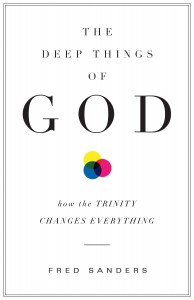 My book on the Trinity is officially released today: The Deep Things of God: How the Trinity Changes Everything. Here’s a thought based on the book, though I don’t put it exactly this way there.
My book on the Trinity is officially released today: The Deep Things of God: How the Trinity Changes Everything. Here’s a thought based on the book, though I don’t put it exactly this way there.
A lot of Bible-believing Christians have trouble seeing the doctrine of the Trinity in Scripture. They see a verse here and a verse there that help prove the different parts of the doctrine (the deity of Christ, the unity of God, etc), but they don’t see the whole package put together in any one place.
Granting that the doctrine is not compactly gathered into any one verse (not even Matthew 28:19 or 2 Corinthians 13:14 are quite as complete or detailed as we’d like), we can take some steps toward thinking about the doctrine in a bigger-than-one-verse way.
Follow the whole argument of Galatians 4, for example, or 1 Corinthians 2, or of Ephesians 1, or of the Gospel of John, and you’ll see the Trinitarian profile of God’s self-revelation emerge clearly. You have to learn to think in bigger sections of Scripture than just a verse; the bigger the better.
This is the key to seeing what’s really there in Scripture: To get to the doctrine of the Trinity, you have to take three very large mental steps.
1. Read the whole Bible. Okay, maybe you can put off Habakkuk and Jude for a while. But you have to achieve some initial mastery of the long, main lines of the one story that is the Christian Bible. You have to be able to think back and forth along the canon of scripture, with figures like Abraham and Moses and David and Cyrus standing in their proper places, and with categories like temple and sonship and holiness lighting up the various books as appropriate. Get comfortable with the whole volume.
2. Understand the shape of God’s economy. The next step is to comprehend the entire Bible as the official, inspired report of the one central thing that God is doing for the world. He has ordered all of these words and events that are recorded in Scripture toward one end. It’s not good enough just to know the content of the whole Bible, if you misinterpret it as a haphazard assemblage of divine stops and starts. These are not disparate Bible stories, but the written form of the one grand movement in which God disposes all his works and words toward making himself known and present. (For details on what “God’s economy” is, see chapter 4 of Deep Things).
3. Recognize the economy as a revelation of who God is. There is still a third step, and it’s the biggest one of all. When you know the entire Bible, and understand that it presents to us God’s well-ordered economy, you still have to come to see that God is making himself known to us in that economy. After all, it is theoretically possible for God to do great things in world history without really giving away his character or disclosing his identity in doing so. This final step on the way to the doctrine of the Trinity is the recognition that God behaved as Father, Son, and Spirit in the economy because he was revealing to us who he eternally is, in himself. He wasn’t messing around with that Son and Spirit stuff. He put himself into the gospel.
That is the right way to interpret the Bible. It’s also the traditional way, recognized by the church fathers and the reformers. It’s also the Christian way. It yields the doctrine of the Trinity, not in scattered verses here and there that tell us a weird doctrine at the margins of the faith, but as the main point.